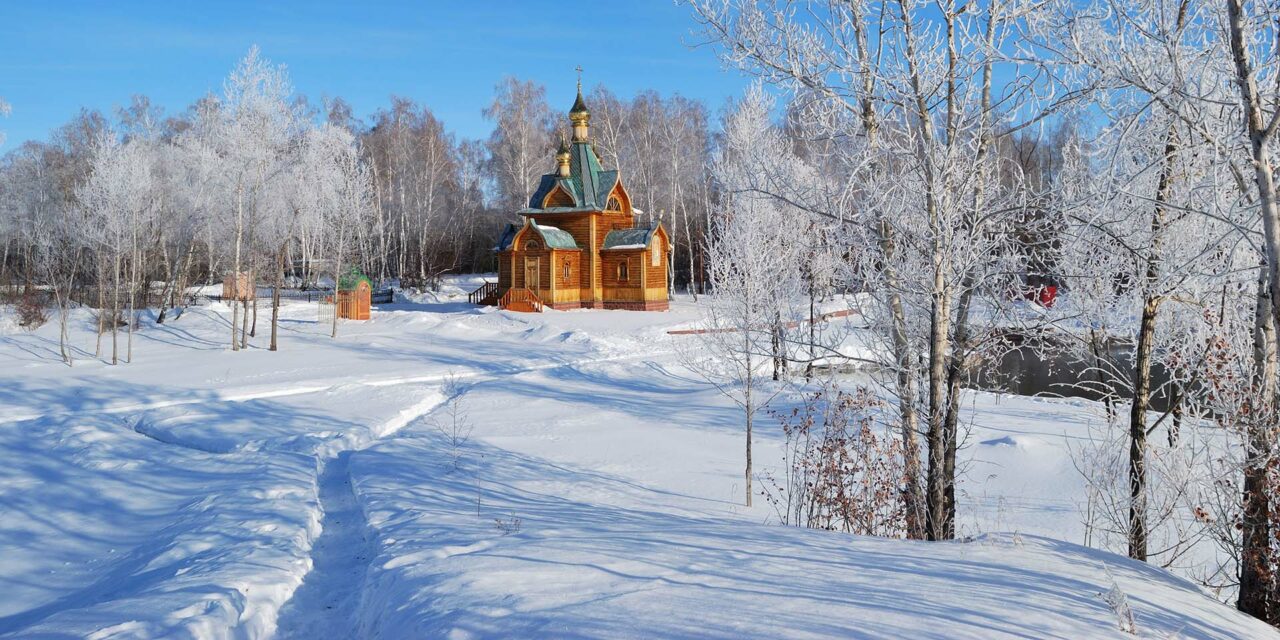WRITTEN BY
Editor, Travelogues
PUBLISHED
September 12, 2017
LOCATION
Siberia
Right now the colors are still changing, but next month South Siberia takes on a new, whiter hue, the towns and villages painted in a soft, bright snow. From October on, the frozen area north of Kazakhstan – distinct from the more northern areas of Siberia and the more populous west – gets a little bit more magical.
The region between Tomsk and Tobolsk features lands of fairytale, literature, and frozen architecture somehow thriving in the cold wastes. Some seem untouched by time, others are falling apart in the most remarkable ways.
Tomsk to Novosibirsk

ABOVE: Spasskaya Tower overlooking Tomsk.
Tomsk is a quaint eastern Siberian town, known as the Siberian Athens, surrounded by vast taiga forests and swamps, but don’t take our word for it. Listen to the melodic words of Russia’s greatest playwright, Anton Chekhov: “Tomsk isn’t worth a brass nickel…an incredibly boring city…. the people are incredibly boring…the city is full of drunks…endlessly muddy…the maid at the local tavern wiped my spoon on her butt before giving it to me.”
The reason this phrase is remembered is because, rather than just saying “suck it” to the old Chek-ster, in 2004, still sore from the insult, they erected a statue of him looking particularly grumpy and silly. Who’s brass nickel now, Anton?

ABOVE: A satirical statue of playwright Anton Chekhov in Tomsk, erected in response to his criticisms of the city.
Ironic statues aside, Tomsk architecture is fascinating: unique wooden houses with intricate lace “gingerbread” decorations straight out of a Brothers Grimm tale. Strolls along the river banks offer glimpses of the town’s unique architecture, with the panoramic scenery from the viewpoint at the history museum a particular favorite. In winter, the wooden buildings stand stark against the snowy whites of the season.

ABOVE: The garishly decorous windows of Tomsk are a highlight any time of year.
The best time to meander toward Slavyansky Bazar, the swankiest restaurant in town, is when the darkness begins to fall. Dinner times in Russia are later in the evening, but the delightfully savory dishes are worth the wait: stroganoff, borscht, and pelmeni.
Even Chekhov had to give them credit for the food: “The dinners here are excellent,” he said, “unlike the women who are rough to the touch.”
Trans-Siberian to Omsk

ABOVE: Snow on the River Ob outside Novosibirsk.
Boarding in Novosibirsk, travelers will take off on the Trans-Siberian Railway to Omsk. The route, depending on the time of year, passes steppes of white and evergreen forests. The first stop, Omsk, may be familiar to literature fans.
Omsk is particularly famous for the exile and conviction of the immortal Fyodor Dostoevsky, convicted as a conspirator against the Tsar regime. He is commemorated in various ways throughout the town in the form of a statue, a memorial museum, and a local university.

ABOVE: Ice sculpture in an Omsk park.
It is easy to navigate to the ancient city of Omsk, split by the River Irtysh into two sections, which offers plenty of cultural merits to explore. Omsk’s – which is tricky to say if you’ve had a few warm vodkas – historical culture is found in the Achair convent, a gorgeous building on the site of a former gulag where thousands of prisoners were executed, just outside the city.

ABOVE: Achair convent outside of Omsk, an outstanding Siberian building with a fascinating history.
Today, the premise functions as a holy monastery with sacred waters – available for a rejuvenating dip in the summers. Nearby, if the skies are empty and the snows are deep, the Church of Saint John the Baptist makes for some excellent photography.
The train between Omsk and Tyumen is quite the journey, leaving plenty of time to relax on board and admire the evolving landscape from the window.
Tyumen to Tobolsk

ABOVE: A modern Tyumen home in the winter.
As the first-ever Russian settlement in Siberia, Tyumen has been an important industrial and economic center for quite some time. Originally founded on an ancient trade route from Central Asia to the Volga River region, the city is best known for its formidable former fortress and the appealing architectural marvel of the Riverside Trinity Monastery, Kremlin-style with gold tipped domes.

ABOVE: Colorful wooden homes in Tyumen.
Tyumen is the stepping stone to the stunning town of Tobolsk, one of the most well-preserved cities in Siberia – for a rather dark reason. Having been burnt to the ground and rebuilt again no less than seventeen times, a Tsar finally ordered it rebuilt in stone, preserving its legacy.

ABOVE: A horse pulls passengers in the height of winter in Tobolsk. In Siberia, season is the key to travel.
Dining choices in Tobolsk are vast, but by far the best experience in town, immensely popular with locals and visitors alike, is a meal in the upmarket Romanov restaurant, where diners savor 19th-century-style Russian dishes in the company of soft piano music.
The road and rails between Tomsk and Tobolsk can be tricky to travel, and the right season is essential. The snows of South Siberia are magical, but one can have too much of a good thing.


